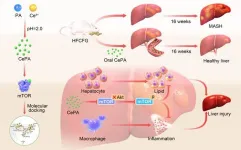(Press-News.org) Billions of dollars in foreign aid could be spent more effectively if international poverty statistics were more accurate, according to new research led by King's College London.
Dr Michail Moatsos, a research fellow in the Department of International Development, says current methods for calculating the international poverty line lead to a skewed picture of how poverty is distributed across the world – and this is hampering attempts to eradicate it.
“Currently, international donors cannot prioritise their funds based on the best possible information and therefore funnel those funds to those most in need around the world. A $2.15 per day poverty line affords very different living standards across countries - even across low-income countries alone,” he said.
The newly published statistical analysis, published in the journal Humanities and Social Science Communications – Nature, tests the current method of poverty line calculation and demonstrates several flaws in both its methods and its findings.
As an example, Dr Moatsos points to the COVID pandemic, which in all likelihood increased the number of individuals living in conditions of poverty across the world. Yet, he says, the amount of uncertainty in the calculation of the poverty line do not allow us to even pinpoint the level of that increase - let alone its geographic distribution - at any reasonable level of certainty on a global scale.
The international poverty line is produced by the World Bank, by taking the middle, or median, value of national poverty lines created for every low-income country.
National Poverty Lines in middle- and low-income countries are generally calculated as the cost of food that would allow for enough calories on average - typically around 2100kcal per day per person - and on top of that, a non-food budget to account for expenses on housing, education, health, heating, transportation, clothing, communications, and other relatively basic needs.
The most important aspect is its cross-country comparability, which ensures similar living standards are being compared across nations.
Dr Moatsos said if a poverty line fails to do that, then our understanding of poverty is “very fuzzy”, and policy cannot be well informed from a global standpoint.
For example, when updating the value of the international poverty line for the latest data, which results at a line of US$2.15 per day in 2017 prices, the World Bank claims that the impact of this updating on the poverty statistics is marginal.
However, Dr Moatsos and his co-author, Dr Achillefs Lazopoulos from ETH Zurich, demonstrate that the difference is as much as 190 million individuals.
The main problem with the current method, they say, lies in the comparisons of ‘purchasing power’ which sits at the heart of the poverty line calculations. Purchasing power parities are used by economists to compare average incomes across countries but is sometimes also used in comparing living standards.
It is a compelling, and easy to apply, idea, says Dr Moatsos, but has many issues in practice, which end up skewing international comparisons of poverty.
“By judging global poverty with living standards that differ across countries we are not able to properly inform policy and distribution of funds on a global scale, and so the current approach delivers a misleading shortcut method,” he said.
“It is our view that any ‘one-size-fits-almost-all’ approach should be abandoned in monitoring global poverty, and a proper definition of absolute poverty should form the basis of a new approach,” the stud authors write.
Dr Moatsos says a better alternative already exists, with the agreement of 186 UN member states on the UN's Copenhagen Declaration on Social Development in 1995 that defines what absolute poverty is. However, this is not yet implemented consistently across member states.
The authors conclude that “the adoption of alternative methods for monitoring global poverty should be considered in official capacity with urgency”.
Ends
END
Current international poverty line a ‘misleading shortcut method’, say experts
Almost 200 million people were moved out of poverty globally by tweak to World Bank calculation
2024-07-16
ELSE PRESS RELEASES FROM THIS DATE:
Food aroma study may help explain why meals taste bad in space
2024-07-16
Scientists from RMIT University have led a world-first study on common food aromas that may help explain why astronauts report that meals taste bland in space and struggle to eat their normal nutritional intake.
This research, which is published in the International Journal of Food Science and Technology, has broader implications for improving the diets of isolated people, including nursing home residents, by personalising aromas to enhance the flavour of their food.
Previous research has shown that aroma plays a big role in the flavour of food.
The team in this study tested how people perceived vanilla and almond extracts and lemon essential oil changed from normal environments on ...
Weather experts discover new effect of storm - in a teacup
2024-07-16
Britain, prepare for deep depression: storms ruin tea.
A new study reveals that Storm Ciaran cut an invisible path of mayhem across southern Britain last autumn, destroying any possibility that 20 million people could have a proper cup of tea at breakfast.
The storm's record-breaking low pressure meant the boiling point of water was below the crucial 100 degrees Celsius required for a decent cuppa, meteorologists at the University of Reading have discovered.
In a study published today [Tuesday, 16 July] in the journal Weather, the scientists reported that water in Reading was boiling at just 98°C.
During the storm on the morning of November 2, ...
Sorry, I didn’t get that: evaluating usability issues with AI-assisted smart speakers
2024-07-16
With the rapid development of AI technology, voice-controlled smart speakers are becoming increasingly popular due to their convenience and ability to control compatible home devices. Despite the rise in use, smart speakers often do not have screens and little-to-none of the visual information feedback common to manually operated devices. This aspect complicates their usability, thus providing room for research and subsequent improvement.
As such, a research team led by Dr. Toshihisa Doi, a lecturer at Osaka Metropolitan University’s Graduate School of Human Life and Ecology, recruited 39 young adults (22 males and ...
Phytic acid-based nanomedicine against mTOR for metabolic dysfunction-associated steatohepatitis therapy
2024-07-16
Metabolic dysfunction-associated steatohepatitis (MASH) is one of the most common chronic liver diseases, primarily caused by metabolic disorders and systemic inflammatory responses. Although the incidence of MASH is gradually increasing, there is a lack of effective drugs and methods for its treatment, thus limiting therapeutic options for MASH. Professor Liu Lei's team has long focused on the treatment and molecular mechanisms of liver-related diseases. Due to cerium's significant antioxidant and anti-inflammatory activities, as well as its hepatophilicity and good biosafety, it shows great potential ...
Research spotlight: The impact of tobacco smoking and smoking cessation on the life expectancy of people with HIV in South Africa
2024-07-16
Krishna Reddy, MD, MS, a physician-investigator at the Medical Practice Evaluation Center and the Tobacco Research and Treatment Center at Massachusetts General Hospital and an Associate Professor of Medicine at Harvard Medical School, is the senior author of a recently published paper in Journal of the International AIDS Society: Tobacco Smoking, Smoking Cessation and Life Expectancy Among People with HIV on Antiretroviral Therapy in South Africa: A Simulation Modelling Study.
What Question Were You Investigating in this Study?
Now that more people with HIV in South Africa are on antiretroviral therapy (medicines to treat ...
Tulane awarded $11.2 million NIH grant to pioneer sex-based precision medicine
2024-07-16
If a man and a woman each suffer a heart attack, you may assume the symptoms and diagnoses should be the same.
That’s not always the case. While men are more likely to show the more “typical” signs of a heart attack — chest pains, shortness of breath — women are more likely to experience pain in their necks or symptoms that feel like heartburn or nausea. An angiogram that shows a blockage in male blood vessels may not show occlusion in a woman’s smaller vessels, and these differences can lead ...
Study reveals dual role of protein in cancer treatment
2024-07-16
Investigators at the UCLA Health Jonsson Comprehensive Cancer Center have uncovered new details about the role of a protein called interferon regulatory factor (IRF1) in cancer progression and treatment response, offering new insight that can potentially help improve the effectiveness of cancer immunotherapy.
The study, published in Cell Reports, reveals how IRF1 can both hinder and help the body's immune response to tumors, depending upon which cells the protein is found in.
“We know IRF1 plays ...
Friends and at-risk youth may need extra support for their mental well-being
2024-07-16
Friends of young people who self-harm or have suicidal thoughts may need additional support to prevent negative outcomes on their own mental wellbeing, in addition to the support needed by young people who self-harm.
While much research rightly focuses on young people at risk and their families, friendships are rarely considered in research into self-harm, according to a new study from experts at the University of Birmingham.
In an extensive literature review, the team set out to draw together all the research in this area to reach a better understanding of common themes around friendship and self-harm ...
Children living in deprived areas are three times more likely to need dental extractions in hospital
2024-07-16
Researchers at Queen Mary University of London have found that children living in areas with high levels of deprivation are three times more likely to have severe tooth decay that requires a dental extraction in hospital, compared with children living in more affluent areas. The findings highlight an urgent need for equitable access to preventive dentistry.
In the study, published today (16 July 2024) in BMJ Public Health, researchers analysed de-identified GP and hospital records for 600,000 children ...
Lowering systolic blood pressure below 120 mmHg may reduce dementia risk among Black, Latino populations
2024-07-16
FOR IMMEDIATE RELEASE
Monday, July 15, 2024
Contact:
Jillian McKoy, jpmckoy@bu.edu
Michael Saunders, msaunder@bu.edu
##
Lowering Systolic Blood Pressure below 120 mmHg May Reduce Dementia Risk Among Black, Latino Populations
A new study suggests that reducing systolic blood pressure below the clinically safe threshold of 120 mmHg over time may produce slight health-protective benefits against late-life dementia and help reduce racial and ethnic disparities in both hypertension and hypertension control.
Hypertension is one of the most modifiable risk factors for dementia, but most research on dementia risk reduction through blood ...
LAST 30 PRESS RELEASES:
This new understanding of T cell receptors may improve cancer immunotherapies
A new fossil face sheds light on early migrations of ancient human ancestor
A new immunotherapy approach could work for many types of cancer
A new way to diagnose deadly lung infections and save lives
40 percent of MRI signals do not correspond to actual brain activity
How brain-inspired algorithms could drive down AI energy costs
Gum disease may be linked to plaque buildup in arteries, higher risk of major CVD events
Contrails are a major driver of aviation’s climate impact
Structure of dopamine-releasing neurons relates to the type of circuits they form for smell-processing
Reducing social isolation protects the brain in later life
Keeping the heart healthy increases longevity even after cancer
Young adults commonly mix cannabis with nicotine and tobacco
Comprehensive review illuminates tau protein's dual nature in brain health, disease, and emerging psychiatric connections
Book prepares K-12 leaders for the next public health crisis
Storms in the Southern Ocean mitigates global warming
Seals on the move: Research reveals key data for offshore development and international ecology
Sports injuries sustained during your period might be more severe
World's first successful 2 Tbit/s free-space optical communication using small optical terminals mountable on satellites and HAPS
Can intimate relationships affect your heart? New study says ‘yes’
Scalable and healable gradient textiles for multi‑scenario radiative cooling via bicomponent blow spinning
Research shows informed traders never let a good climate crisis go to waste
Intelligent XGBoost framework enhances asphalt pavement skid resistance assessment
Dual-function biomaterials for postoperative osteosarcoma: Tumor suppression and bone regeneration
New framework reveals where transport emissions concentrate in Singapore
NTP-enhanced lattice oxygen activation in Ce-Co catalysts for low-temperature soot combustion
Synergistic interface engineering in Cu-Zn-Ce catalysts for efficient CO2 hydrogenation to methanol
COVID-19 leaves a lasting mark on the human brain
Scientists use ultrasound to soften and treat cancer tumors without damaging healthy tissue
Community swimming program for Black youth boosts skills, sense of belonging, study finds
Specific depressive symptoms in midlife linked to increased dementia risk
[Press-News.org] Current international poverty line a ‘misleading shortcut method’, say expertsAlmost 200 million people were moved out of poverty globally by tweak to World Bank calculation


